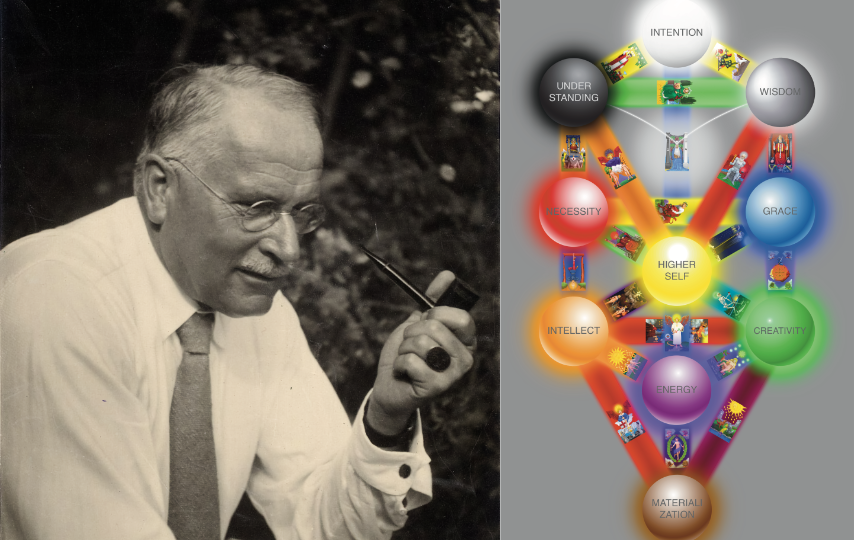

This article investigates the connection between Tarot and some of Carl Jung’s psychological concepts.
Jung’s theories have influenced contemporary Tarot practitioners, who use Tarot to gain psychological insight rather than for fortunetelling. Further, some therapists employ Tarot images to help clients with self-realization and self-development.
Tarot Cards & the History of Enlightenment

According to Paul Foster Case (Highlights of Tarot), some 800 years ago, during the golden age of Islamic learning and when the Crusades were in full swing, something wonderful happened in the history of enlightenment.
Before this time, enlightenment was only available in the form of scriptures, which were cryptic, allegoric, and scarce. Moreover, only around 7.5% of the European population could read.
To meet that challenge, wise men and women from around the world gathered in Fez, Morocco, to design an enlightenment picture book. This picture book became known as the Tree of Life and Tarot.
The Tree of Life and Tarot draw a formidable map of the human self that spans four levels: the spiritual, the creative-feely, the intellectual, and the bodily levels.
Hence, the Tree of Life and Tarot are not only spiritual tools but are also, by nature, psychological tools.
The Collective Subconscious, Archetypes, Individuation, and Synchronicity
Carl Jung introduced several concepts to psychology, of which five are relevant to this article.
A. The personal and collective subconsciousness: Jung proposed that subconsciousness has two layers: the personal subconsciousness and the impersonal, collective subconsciousness that all humans share.
B. Archetypes: According to Jung, archetypes are primordial images, symbols, and patterns that populate the collective subconsciousness. They recur across cultures and time periods and manifest in myths, dreams, and art. Famous examples are the animus and anima, the male and female principle of consciousness.
C. Individuation: This is the process of integrating various aspects of the self, in particular, the shadow self. The purpose is self-realization and wholeness. Individuation is transformative work, and that’s why Jung also called it inner alchemy.
D. Synchronicity: Jung’s concept of synchronicity refers to meaningful coincidences, where seemingly unrelated events connect in a meaningful way.
E. Shadow Work: The shadow is the dark side of subconsciousness that holds wild, often destructive personality traits. Shadow work means bringing the dark characteristics of our self to conscious attention and training to use them constructively. Examples: burning anger in the gym or transforming frustration at work into the determination to ask for a raise.
The Language of Consciousness
Our conscious self speaks English, German, or Chinese. It also thinks in its native language. Observe your thoughts, and you find that every time you formulate a thought, a voice in your head constructs a sentence expressing that thought.

Other levels of consciousness, for example, subconsciousness, speak the language of consciousness, which is pictorial and symbolic.
Subconsciousness uses symbolic images to talk to us in dreams.
The language of consciousness and the Jungian archetypes are connected. Think of the archetypes as the vocabulary of the language of consciousness.
Tarot Cards and Archetypes
Consciousness archetypes populate Tarot cards, too. For instance, you can find the animus and anima in many Tarot cards in the symbolic image of a man and woman.
The authors of Tarot used the language of consciousness to illustrate positive states of consciousness. Its images speak directly to our subconsciousness, which understands them perfectly. And that’s why Tarot images can have a corrective and healing influence on our minds and establish a positive world view, self view, and future view.
For instance, working with the Intuition card, aka The Hierophant, makes us more receptive to the higher self’s guidance, protection, and inspiration. Working with the Attention card, aka The Magician, improves focus. Working with the Generation card, aka The Empress, boosts creativity.
On a side note, this means that we can use Tarot symbolism to interpret dreams.
Tarot Readings and Synchronicity
Tarot readings align with Jung’s concept of synchronicity, where seemingly unrelated events—the drawing of Tarot cards – connect in a significant, symbolic way by producing a spread that can shed light on the querent’s inner life.
Psychological Tarot readings can also trace back adversity to the querent’s weaknesses. Think of it as karmic forensics. As subconsciousness speaks to us in dreams, it can draw those Tarot cards from a stack, which show the mental principles involved in the adversity we experience.
Tarot and Individuation
Tarot cards have therapeutic benefits and can help with individuation (self-unification).

The Tree of Life and the Tarot cards show a unified, spiritual self. Tarot cards illustrate positive, spiritual states of mind and can heal the mind. Mind that the concept of healing includes wholeness. Healing comes from the old English word hælan, which means to make whole, sound, or well.
Looking at Tarot cards can evoke, like Rorschach inkblots, responses from our subconsciousness and bring unconscious issues to the surface. This illuminates our shadow and helps to initiate shadow work. Shadow work confronts unresolved traumas, negative thoughts, and bad habits and transforms them.
Further, a Tarot spread stimulates the mind’s natural capacity to associate, thus connecting the dots between experiences, memories, and unconscious thoughts, leading to further psychological insights.
Since Tarot cards, in particular, the major arcana, show both positive and enlightened states of mind, meditating with Tarot cards can lift our self-awareness from the ego to our soul. This higher vista allows for the integration of the self’s fragmented parts, i.e. individuation.
But we can go even further. The Tree of Life is a map of the totality of the human self that spans four realities or universes if you so will. As we ascend the Tree of Life we become aware of higher, hitherto unknown levels of our selves and other realities.
Are you interested in a psychological Tarot deck? Check out the Enlightenment Tarot.
Subscribe to receive the free copy of a guide on how to perform psychological Tarot readings.
